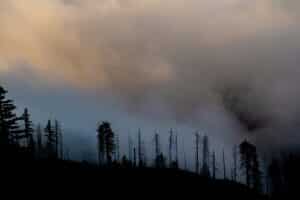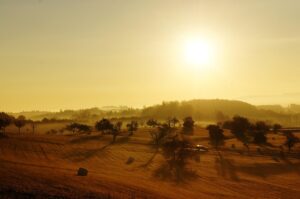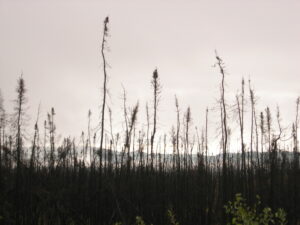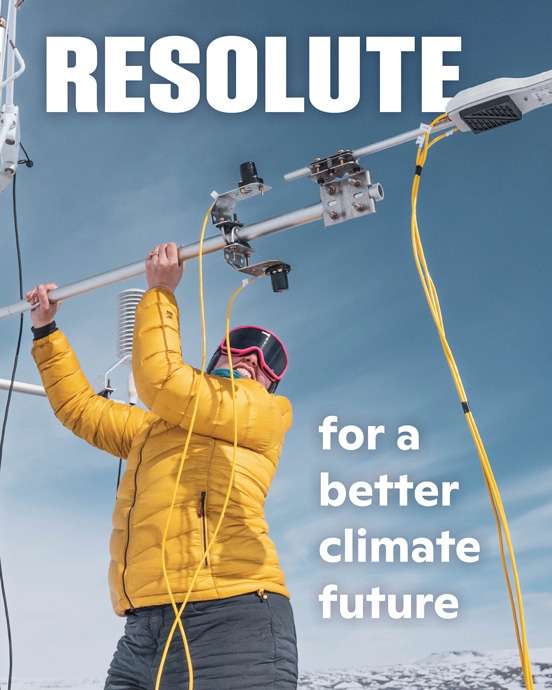Meeting the moment: Fund for Climate Solutions awards five new grants
From Mongolia to the Cerrado, FCS projects are tackling climate’s most pressing research questions
By Maggie Lin
The second round of 2025 Fund for Climate Solutions (FCS) awardees has been announced. The FCS advances innovative, solutions-oriented climate science through a competitive, internal, and cross-disciplinary funding process. Generous donor support has enabled us to raise more than $10 million towards the FCS, funding 79 research grants since 2018. In a volatile environment for climate research and policy, this summer’s five collaborative project teams are bringing their ambition and creativity to solutions that meet time-sensitive needs.
Additional funding will help to expand the Fund for Climate Solutions. If you are interested in learning more, contact Leslie Kolterman at lkolterman@woodwellclimate.org or (508) 444-1584.
Tracking forest structure and emissions from logging mature and old-growth forests on federal lands
Leads: Dr. Richard Birdsey, Dr. Wayne Walker, Seth Gorelik
The federal administration has ordered the Forest Service and Bureau of Land Management to increase logging of federal forests by 25% over the next few years, with detailed project-level planning expected before the end of 2025. There are few, if any, guardrails that protect the most valuable young, mature, and old-growth forests. With collaborators from Conservation Biology Institute, World Resources Institute, and Natural Resources Defense Council, this project will track carbon stock reductions from greatly scaled up logging, especially where it targets older forests. The team will also model the impacts of a 25% increase in logging across all federal lands. Their methods build upon extensive prior research, and will integrate data from satellite observations, forest inventories, and published activity reports to provide analysis that can support public engagement and policy analysis.
Mongolia grazing lands initiative: Knowledge co-production and mapping with Dukha reindeer herders in Mongolia
Leads: Greg Fiske, Christina Shintani, Jackie Dean
The Dukha people of Mongolia, like other Indigenous peoples, have lived respectfully and in harmony with the land since time immemorial. Now, their lifeways are being challenged by climate change and land use decisions made without proper consultation and consent. On the Mongolian Plateau, the rate of summertime warming is three times faster than the average for Northern Hemisphere lands, causing permafrost thaw and changes in vegetation. The project team will map land use changes impacting Indigenous grazing lands in Mongolia and train Indigenous reindeer herders in GIS map storytelling tools. Grounded in co-production of knowledge, this work will build on past successes working with Sámi reindeer herders in Norway and Indigenous communities in Alaska. It will also expand Woodwell’s rangeland work into East Asia, leveraging existing partnerships with Esri and the International Centre for Reindeer Husbandry.
A novel framework for defining and quantifying degradation in fire-prone tropical forests
Lead: Dr. Manoela Machado
Collaborators: Dr. Andréa Castanho, Dr. Marcia Macedo, Dr. Wayne Walker
Brazil’s vast tropical savanna, the Cerrado, is both a global biodiversity hotspot and a provider of vital ecosystem services. It is experiencing the highest deforestation rates among Brazilian biomes, driven primarily by the expansion of mechanized agriculture—nearly half of the Cerrado’s original vegetation is already lost. The region has weaker legal protections than the Amazon, resulting in land conversion being displaced into the Cerrado. Part of the challenge is that defining and measuring degradation in the Cerrado can’t be reduced to the loss of biomass alone: the biome is dependent on disturbances like fire that temporarily reduce biomass, but are also essential for sustaining ecological integrity. This project responds to increasingly urgent calls from government agencies, environmental nonprofits, and carbon market participants to develop an operational framework of Cerrado degradation that accounts for the ecosystem’s natural variability. This project will build Cerrado-specific definitions of degradation and deliver both a monitoring framework and a map assessing 2024 degradation. The team, including collaborators from IPAM and the University of Oxford, plans to build on these outcomes to seek funding for expanding this framework to other disturbance-dependent ecosystems, including savannas around the world.
Responsible solar geoengineering research and governance: Scoping a role for the Woodwell Climate Research Center
Lead: Dr. Peter Frumhoff
Collaborators: Dr. Jennifer Watts, Jamie Cummings, Dr. Brendan Rogers, Dr. Christopher Schwalm, David McGlinchey
Researchers and policymakers are increasingly assessing the effectiveness and risks of solar geoengineering—interventions intended to rapidly cool the Earth by reflecting a portion of incoming sunlight back into space. Woodwell Climate previously established an organizational position that “responsible research is needed to inform decision-making regarding whether and how solar geoengineering should ever be considered for deployment.” This project will investigate whether Woodwell should further responsibly-goverened solar geoengineering research, building on our strong position statement, our distinctive expertise in Arctic warming and federal policy engagement, and our relationships with Arctic Indigenous communities. The team will invite expert speakers for presentations to Woodwell staff; hold a series of scoping interviews with leading researchers, NGOs, Arctic community thought-leaders, and philanthropists; and co-convene an international workshop with the Harvard Kennedy School’s Arctic Initiative.
Understanding how wildfire impacts permafrost thaw depths
Leads: Dr. Anna Talucci, Dr. Brendan Rogers
Collaborators: Dr. Elchin Jafarov, Dr. Kayla Mathes, Dr. Christina Schädel
When high-latitude northern landscapes experience wildfire, plants and organic matter in the soil are burned away, leading to increased soil temperatures and permafrost thaw. Dr. Anna Talucci previously led a publication that synthesized existing research to drastically increase the amount of data that is available to modelers on the depth of actively thawing and re-freezing ground in burned and unburned research sites across the northern tundra and boreal regions. This project will build on that data to investigate what drives active layer recovery and fill key gaps to support permafrost modeling by Woodwell researchers. The team aims to publish their findings in a scientific journal and submit an abstract to present to colleagues at the next American Geophysical Union annual meeting. They will also develop a funding proposal to seek support in investigating the questions their research reveals about more complex permafrost-wildfire interactions.
IPCC concludes selection of authors for its Seventh Assessment Report

The Intergovernmental Panel on Climate Change (IPCC) has appointed 664 experts from 111 countries to participate in the Seventh Assessment Report (AR7) as Coordinating Lead Authors, Lead Authors and Review Editors.
These experts were nominated by governments and IPCC observer organisations and selected by the IPCC Bureau from a global pool of 3,771 nominees.
Read more on the IPCC website.
As Canada wildfires choke US with smoke, Republicans demand action. But not on climate change

The sternly worded statements and letters are filled with indignation and outrage: Republican U.S. lawmakers say Canada has done too little to contain wildfires and smoke that have fouled the air in several states this summer.
“Instead of enjoying family vacations at Michigan’s beautiful lakes and campgrounds, for the third summer in a row, Michiganders are forced to breathe hazardous air as a result of Canada’s failure to prevent and control wildfires,” read a statement last week from the state’s GOP congressional delegation, echoing similar missives from Republicans in Iowa, New York, North Dakota, Minnesota and Wisconsin.
They’ve demanded more forest thinning, prescribed burns and other measures to prevent fires from starting. They’ve warned the smoke is hurting relations between the countries and suggested the U.S. could make it an issue in tariff talks.
Experts emphasize need for Interior Alaska wildfire mitigation

Earlier this summer, Interior Alaska wildfires were so widespread, Fairbanks resident Nettie La Belle-Hamer had to prepare a go-box in case the flames encroached too closely on her home.
La Belle-Hamer, deputy director of the University of Alaska Fairbanks Geophysical Institute, brought that firsthand experience along with plenty of scientific knowledge to this year’s Arctic Encounter Symposium, an annual conference focused on the region.
La Belle-Hamer was joined by four other panelists — three of whom live in the Interior — to discuss methods to address wildfires in the Arctic, as well as strategies to implement fire mitigation in the Arctic to protect permafrost melt.
Continue reading on Anchorage Daily News.
Late July’s oppressive heat forecast isn’t normal
A punishing heat wave will bring hot temperatures to eastern US and linger for several days, underscoring how climate change heats things up.

As the clock ticks down the final days of July, thermometers will climb across much of the eastern half of the United States, creating a dangerous and long-lasting heat wave that will put millions at risk of heat stroke and other illnesses.
Those in the path of the heat wave should plan to take extra measures to stay cool through at least July 30. Keep things chill by staying in air-conditioned spaces, visit friends with pools, pile up the popsicles and lemonade and pull out the recipe for your favorite cold summer salad.
For 1st time, fires are biggest threat to forests’ climate-fighting superpower
Forests play a major role pulling planet-warming carbon dioxide out of the atmosphere. As the world heats up, some forests are becoming emitters in their own right.

In 2023 and 2024 the world’s forests absorbed only a quarter of the carbon dioxide they did in the beginning of the 21st century, according to data from the World Resources Institute’s Global Forest Watch.
Those back-to-back years of record-breaking wildfires hampered forests’ ability to tuck away billions of tons of carbon dioxide, curbing some of the global warming caused by emissions from burning fossil fuels.
Keep reading on The New York Times.
Woodwell Climate Conversations: Turning the Tide
Climate Progress, Peril, and the Path Ahead
Join Gina McCarthy and Max Holmes for a timely conversation on how bold, science-based action drove historic progress—and what’s at stake as that progress faces new political threats.
Notes from an ecologist: Factoring in rivers and streams when studying bay health

On the morning of July 7, more than a hundred volunteers from Buzzards Bay Coalition Baywatchers fanned out to the more than 30 small embayments that surround Buzzards Bay to collect the first round of this summer’s four sets of water quality samples.
By mid-afternoon we had large and small bottles from more than 200 different stations lined up on the tables at the Woodwell Climate Research Center, where the samples enter an assembly line of different laboratory analyses that include different forms of nitrogen and the concentration of chlorophyll—the main pigment in algae and an excellent metric of the amount of algae in the water.
Read more on The Falmouth Enterprise.




